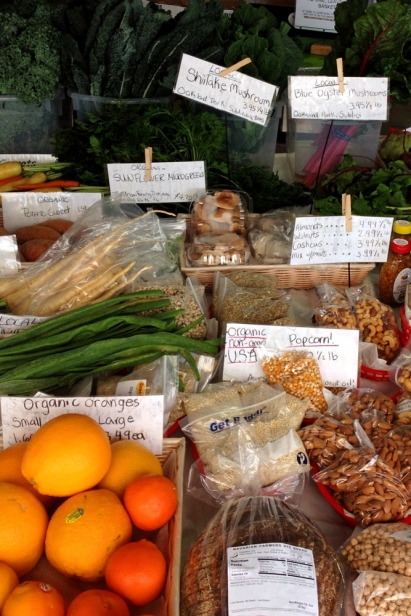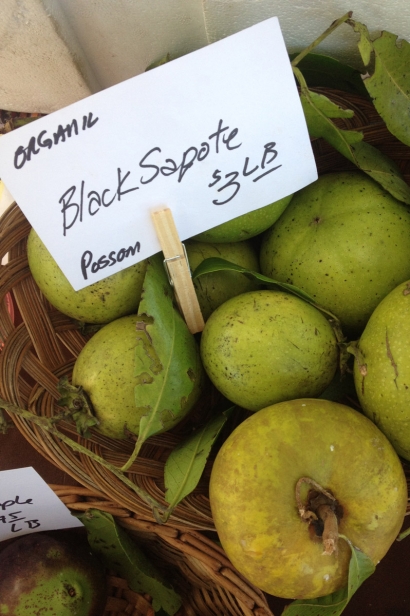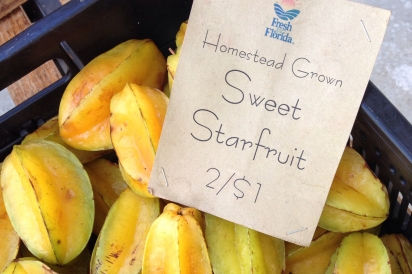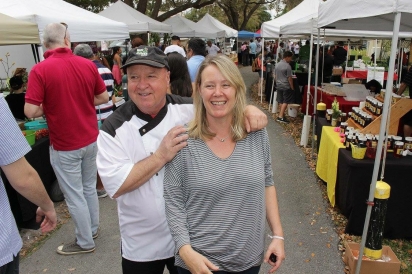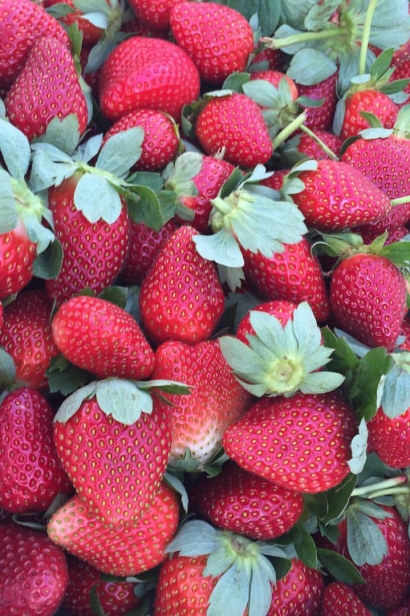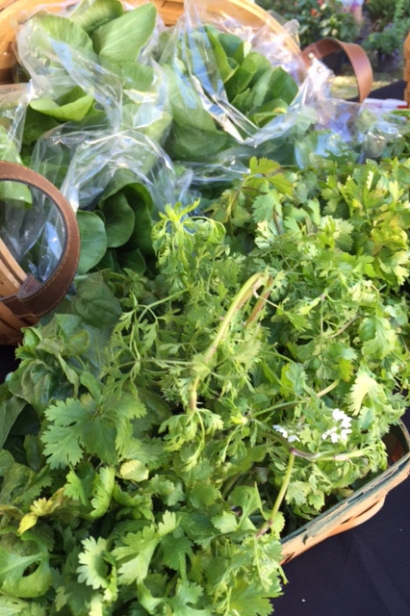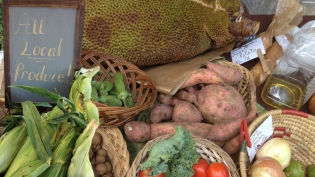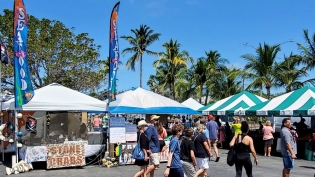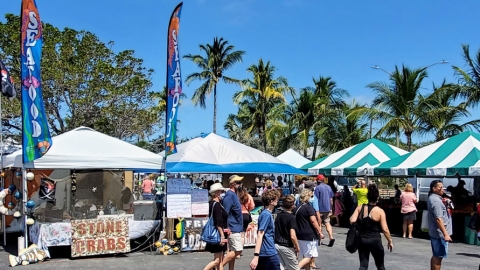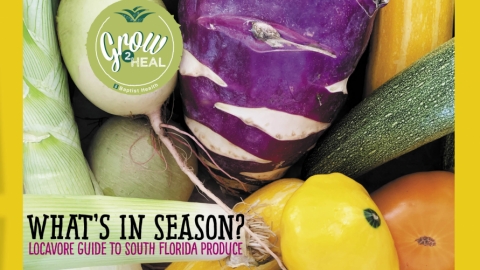Part 2: Some Truths about Farmers Markets
For many, the farmers market is a portrait of America’s abundance: colorful pyramids of tomatoes, stacks upon stacks of sweet corn harvested only hours beforehand, baskets of greens and cabbages, rainbows of peppers and eggplants, tents stretching for blocks. Farmers are there to pull back corn husks to reveal the sugar-sweet kernels, talk up the rhubarb, offer samples of the apples, weigh the asparagus.
In recent years, Florida’s farmers markets have blossomed like so many squash flowers. In the second part of Farm to Fable, Laura Reiley’s recent series in the Tampa Bay Times, she finds plenty of markets on Florida’s west coast. But local farmers? Not so many. Resellers – vendors who sell produce from other farms in Florida, elsewhere in the U.S., or Mexico or Central America – make up many of produce vendors. Sometimes there are no local farmers.
In South Florida, the situation is similar. After all, this is Florida. The rules really are different here.
What prevents our markets from being like those bountiful displays in the Midwest? Our geography and climate, for starters. Too many markets exploding on the scene and not enough local farmers to supply them. Little or no regulatory oversight, like requirements for percentages of local farmers, or labeling of where produce comes from, or even rules on what can be called a farmers market. On top of all this, there are customers who don’t really care whether what they’re buying is local or not.
“We are fortunate to have a year-round growing season,” says Charles LaPradd, Miami-Dade agricultural manager. “We just don’t grow everything year-round.”
What this means is a growing season that hits its peak during the winter months, then slows down in the summer and early fall. When their counterparts in the Midwest are picking their last pears in September and October, South Florida farmers are just getting started. In Homestead and the Redland, they’re planting acres of row crops – tomatoes, cucumbers, squash, corn, beans, eggplant, okra, strawberries, peppers, herbs, onions, lettuces, broccoli, among others – that will feed people well beyond Florida through the winter and early spring. When temps start rising, it’s time for summer tropical produce and fruits: okra, avocado, carambola, dragon fruit, jackfruit, lychee, mamey, mango, plus sweet potato, callaloo, taro. And some fruits and vegetables flourish year-round – bananas, coconut, boniato, guava, papaya, to name a few.
Of course, not everything thrives in South Florida. Plant hardiness zones here – based on the average annual extreme minimum temperatures – range from 10B in Broward and west Miami-Dade to 11B in the lower Keys, so fruits and vegetables that require cool temperatures, like rhubarb, apples, pears, asparagus, nectarines, peaches and plums, aren’t grown here, at least not commercially.
Typically, on a stroll through South Florida markets from mid-December through mid-April, visitors will see tables filled with baskets of kale and greens, heirloom tomatoes and eggplants, herbs, cut flowers, beets and radishes, green and yellow beans, plus some tropical fruits, like jackfruit. But only a few months later, the sweltering heat and humidity of summer has set in. Those tables staffed by local farmers – unless they decide these markets aren't work their time – now have a sparse display of okra, callaloo, boniato, avocado, mango and dragonfruit.
Farmers markets sprout up like weeds
Seven years ago, there were a dozen or so farmers markets in South Florida. Today, the number is closer to 50 – some seasonal, others year-round. Most markets are open on weekends, so local farmers are spread thin, choosing the busier markets to make the most of their limited resources.
At these markets, you may see names like Bee Heaven Farm, Teena’s Pride, Paradise Farms, Verde Community Farm, V & B Farms, Treehugger Organic Farms, Health and Happiness, Little River Cooperative, Cerasee Farm, Possum Trot, Harpke Family Farm, Flagler Village, Dania Beach PATCH, Green Dean, Three Sisters Farm, LNB Groves and Sun Fresh Farm. These farms, and others, supply markets and sometimes restaurants with fresh produce and may extend their reach into the community by offering CSAs (community supported agriculture).
Also at markets are farmers who sell their own produce, but also bring in fruits and vegetables from elsewhere. At the height of the season, nearly all of their produce may be from their own farms, supplemented by produce they buy from farms farther afield – Immokalee and points north, Georgia, the Carolinas. You may hear the phrase "extended local," which ideally means resellers are bringing in good-quality produce from farms they know to add needed variety to the market.
“My customers want to get all their shopping done,” one farmer tells us. “I can’t grow everything they want, so I get it from farms I know.”
Finally, there are resellers who buy wholesale produce and sell it alongside local farmers. This could be boxes of grapes, potatoes and onions, pristine peppers or less-than-perfect mangos. Their sources for these vegetables could be huge wholesale produce distributors, or cash-and-carry boxes of discounted produce from anywhere, found in places like the warehouse district at NW 21st St. and 12th Avenue in Miami. Resellers pick up bargains that allows them to undercut their local counterparts. As Reiley points out in her story, these resellers may peel off labels of this produce and set up their market displays. Unless the consumer knows otherwise, their produce may look no different than what the local farmers are selling.
Why buying local produce matters
• It’s fresher and retains nutrients longer
• The carbon footprint is smaller because it hasn’t had to travel far
• You’re supporting the local economy: the farmer and farm workers, the market and the community
Knowing what's in season
When you see strawberries in the market in July, or apples any time at a Florida farmers market, they came from somewhere else, period. If buying local produce is important to you, you’ll need to know what grows in South Florida and when. One helpful tool is Redland Raised, a Miami-Dade program that labels local produce in supermarkets, identifying fruits and vegetables grown here. Another is a harvest calendar we created that lists produce and the months they’re harvested. Florida Fresh is a handy free app for iPhone or Android created by UF/IFAS that shows what’s in season according to your ZIP code. All these are useful in determining if a particular fruit or vegetable is in season in South Florida and is, therefore, locally grown.
Or – why not just ask the vendor?
As Reiley discovered in her story, there are vendors who just don’t want to tell the truth. And there’s no requirement for them to label where their produce comes from.
“Some vendors are afraid of labeling,” says Urban Oasis Project’s Art Friedrich, who runs the Upper East Side Farmers Market and other markets that – like most local farms – label their products with the name of the farms. “They don’t want people to realize they’re not growing everything.”
Farmer Margie Pikarsky of the certified organic Bee Heaven Farm, believes market management makes it easy for unscrupulous vendors to peddle produce that’s not local.
“Market managers allow deceptions to happen by turning a blind eye, ignoring obvious signs,” she says. “In the case of organic, [they’re] not requiring copies of organic certification for unlabeled (non-commercial) product of the growers from vendor resellers claiming organic products.” Pikarsky has heard false claims like “harvested this morning – yeah, right, by the light of the moon before arriving at market at 6 or 7am?” or “local … yep, it’s local to wherever it was grown … not lying here.”
Still, market managers see a need for resellers in their markets because their customers want the full variety they’ve come to expect after years of shopping in supermarkets. When Gigi Gimenez and Susan Muci took over the busy Pinecrest Farmers Market in 2013, they brought in more local farmers to the mix as part of their plans to make the market more supportive of community agriculture. But not all stayed on, Gimenez says. “Some left because patrons don’t care,” she says. “It was disappointing.” The market continues to use resellers because “they want that romaine,” even if it isn’t local. And resellers can add an educational component. “My Exotic Fruits sells fruits from the outside, but they explain where it’s from,” she says. They’d consider requiring produce vendors to label produce origin if their patrons valued it.
And without resellers, the summer markets, already facing lower turnout because of hot weather and rains, struggle to attract customers.
Too many markets, not enough farmers
Longtime local food advocate Cindy Hill, who founded the nonprofit farm food delivery service Once Upon a Carrot, says Florida simply suffers from a shortage of local farmers as well as distribution problems. “I understand that everyone wants to make a profit and jump on the fruit wagon, but in reality there just isn't enough local product to cover the entire state of Florida with a farmers market now in every little village or town,” she says.
When the Wynwood Farmers Market first opened earlier this year, it had no farmers, says Melissa Frantz, a newcomer to the market scene. “There’s just a limited number of farmers to go around.” But she soon realized they were as essential to her market as food artisans. Her quest took her to local farms, where she met with Jerry Sanchez, a fixture at the seasonal Coral Gables market. Sanchez grows most of what he sells on his family farm, but he also resells produce from elsewhere in Florida. Sanchez says Frantz’ visit was the first time in 20 years of selling at South Florida markets that a manager had ever come to tour his property. To her, visiting the farmers and knowing their local vendors is essential. “We want to build a relationship with them and support local farmers,” she says. “Their margins are so slim.”
And with so many markets and resources spread thin, farmers must make decisions where they can do the best business. Sometimes, that leaves neighborhood markets in the lurch.
Finding farmers for Miami Springs
In 2012, Sarah Vargas launched the seasonal Miami Springs Farmers Market in the close-knit town of 14,000 people because, she says, the local grocery store didn’t offer local produce at that time. She also wanted to be an incubator for local artisan food, and give the community a gathering place – “it just feels good,” she says. After starting her market at All Angels Episcopal Church, in an out-of-the-way field, she was able to move to a more visible location on Curtiss Parkway near the city's downtown circle.
As the only market serving Miami Springs and neighboring Hialeah, the small Saturday morning event gained a reputation where neighbors could sell their backyard avocados, bring the kids and pets and pick up fresh produce, seafood and artisan treats.
Then, in the middle of this past market season – an especially difficult one for growers because of weather – both of her produce vendors bailed out. Urban Oasis Project, a supplier of local and organic produce for the past two years, left in mid-season. “Not selling enough,” says Vargas. Benny’s Produce Stand, a local grower and reseller, took off after four years.
“It was either close the market because it was not legitimate, or try to source it myself,” she says.
Vargas chose the latter. She drove up to the Dania Beach PATCH garden for lettuce and herbs so “incredible” it was worth the drive. In the Redland, she picked strawberries at a U-pic and found onions and tomatoes on the vine. At Urban GreenWorks’ Cerasee Farm in Liberty City, she found letttuce, arugula, mustard greens, chard and bok choy.
Vargas was now a produce vendor – the produce vendor – in addition to being a market manager, so she was determined to make it work. After 25 years in retail, Vargas knew the value of shelf appeal. She found tablecloths and raided the closets of friends and families for baskets and containers. Produce was stored in water to keep it fresh and unwilted. On her chalkboard, she listed the farms she bought from. She priced goods “fairly,” she says. “Let’s be real. We don’t have the demographics of Pinecrest or Coral Gables in Miami Springs. But we still want to eat good food.”
And the result? People loved it, she says. First, customers knew her face so trusted her. She was able to tell them she picked the berries herself in a Kendall field, and got the greens from an urban farm only three miles away. “The reaction was ‘What?! No way!’” says Vargas. “I could personally vouch for it.” She started the market with two or three tables filled with produce, and by the end of the day, she had sold nearly everything. “I’m pretty confident that I was selling more than both of the vendors who left,” she says.
By the time she closed for the season in March, she figures that financially, she broke even as a produce vendor, but succeeded in keeping her market authentic. “In terms of validity – well, that’s my job.”
Still, the farmers market experience has been not been easy for her. Making the 120-mile trip to gather, harvest and pick up produce every week is not something she's ready to do when her seasonal market starts up again in the fall. If the market attracted more regular customers, it would in turn attract more vendors, but public response can be fickle. “I still don’t know what people want from a farmers market. It’s not part of our culture,” she says. The city has been supportive, Vargas says, but she would like to see more help from local government.
What's in a name?
Is it misrepresentation to call South Florida's weekly produce and artisan gatherings farmers markets?
Some think so. “I’ve always been adamant that a market that doesn’t have some actual farmers needs to be called something else – a green market, an outdoor market, anything but,” says Pikarsky.
Elsewhere, such markets are often tightly regulated so that consumers can be assured that they are getting local produce. In California, for example, farmers markets are strictly regulated, certified and even audited. Growers must post signs with the name and location of their farm and say, “We grow what we sell.”
If some form of farmers market regulation were passed in Florida – defining local farmers and requiring a certain percentage to be part of any market, Art Friedrich of Urban Oasis thinks people would get the more authentic experience they crave. “Is it an outdoor food court, a craft fair or a market experience? As long as we keep creating fake farmers markets instead of talking about where our food comes from, it's a distraction.”
Friedrich and Pikarsky agree that requiring all produce vendors to label the origin of their produce is a good start to ensuring transparency in the marketplace. "Requiring organic certificates available on demand, actually required by law, would help for organic claims," says Pikarsky.
Some market managers say they will consider this first step of requiring labeling, especially if their customers let them know it's important to them. So the ball remains in the court of the consumer. If you value local produce in your markets, here are some steps you can take that can lead to better local markets:
- Let your farmers market management know you support local farmers and want to see all produce origins labeled
- Ask questions. Cultivate a relationship with vendors. If you are unsatisfied with answers, let the market manager know
- Take a farm tour, typically offered monthly in the winter and early spring, to learn more about what grows here
And if you're one of those folks who wonders why you should buy locally at all, we recommend shopping at the farmers market instead of the grocery store for produce in season. You may well discover that South Florida fruits and vegetables taste far better than their bland supermarket counterparts. We post recipes specifically using seasonal produce on our website and in our quarterly magazine. Be inspired!




